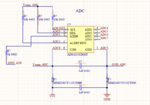decaf14
Newbie level 5

Hello,
I'm a novice PCB designer doing my first mixed-signal board for a thesis project.
I'd like to digitize a signal and was planning to use the ADS1115 ADC in conjuction with the SAMD21G18 microcontroller. I've chosen the ADS1115 specifically because adafruit has a hardware reference design. I noticed in their reference design that they have an odd configuration using ferrite beads. They place a ferrite bead between two grounds to "isolate" one from the other. From what I can infer online, isolating power supplies with ferrite beads is good, but isolating grounds is bad.
Can anyone advise me on this? Please see the attached schematic of the ADS1115 breakout board from adafruit. Note the ferrite bead connections between system ground and system power.

This is my Altium schematic where I've mimicked adafruits design.

Thanks.
I'm a novice PCB designer doing my first mixed-signal board for a thesis project.
I'd like to digitize a signal and was planning to use the ADS1115 ADC in conjuction with the SAMD21G18 microcontroller. I've chosen the ADS1115 specifically because adafruit has a hardware reference design. I noticed in their reference design that they have an odd configuration using ferrite beads. They place a ferrite bead between two grounds to "isolate" one from the other. From what I can infer online, isolating power supplies with ferrite beads is good, but isolating grounds is bad.
Can anyone advise me on this? Please see the attached schematic of the ADS1115 breakout board from adafruit. Note the ferrite bead connections between system ground and system power.

This is my Altium schematic where I've mimicked adafruits design.

Thanks.




